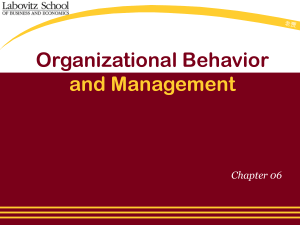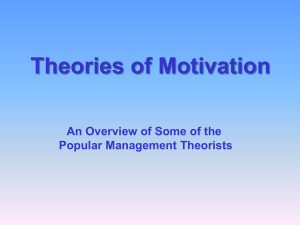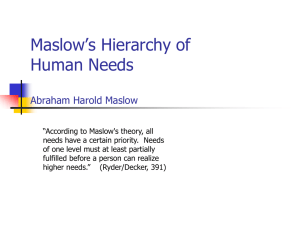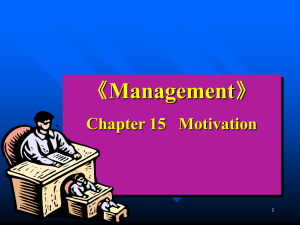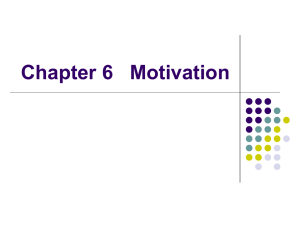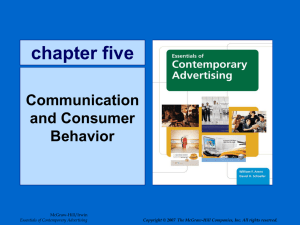Blocking Need Satisfaction
advertisement
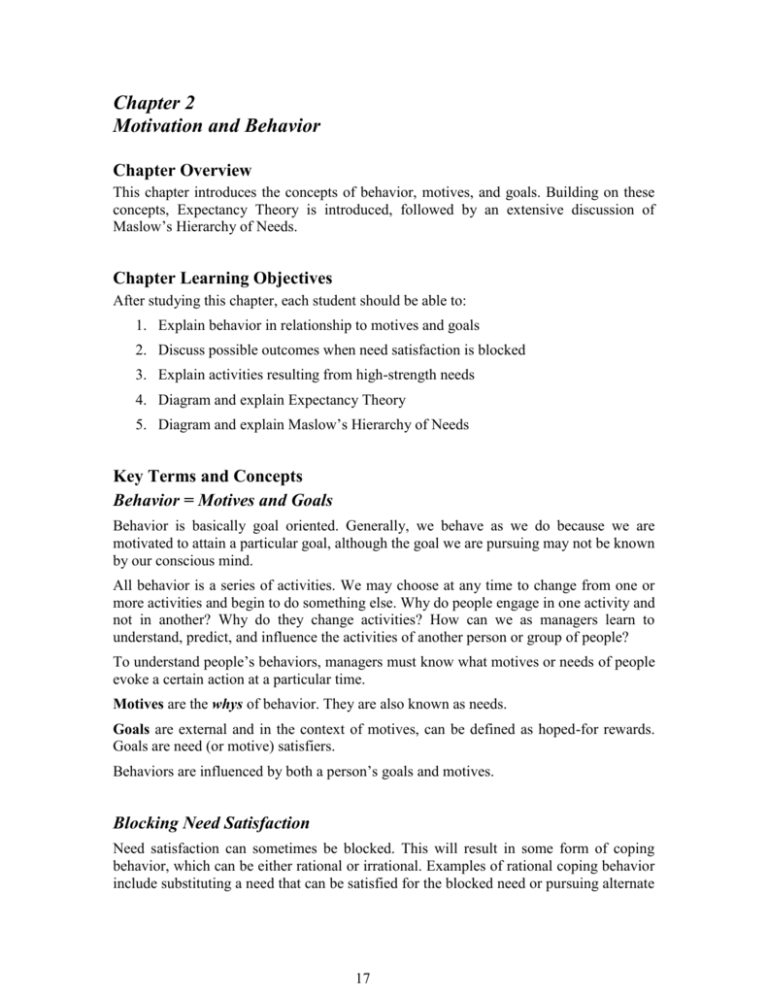
Chapter 2 Motivation and Behavior Chapter Overview This chapter introduces the concepts of behavior, motives, and goals. Building on these concepts, Expectancy Theory is introduced, followed by an extensive discussion of Maslow’s Hierarchy of Needs. Chapter Learning Objectives After studying this chapter, each student should be able to: 1. Explain behavior in relationship to motives and goals 2. Discuss possible outcomes when need satisfaction is blocked 3. Explain activities resulting from high-strength needs 4. Diagram and explain Expectancy Theory 5. Diagram and explain Maslow’s Hierarchy of Needs Key Terms and Concepts Behavior = Motives and Goals Behavior is basically goal oriented. Generally, we behave as we do because we are motivated to attain a particular goal, although the goal we are pursuing may not be known by our conscious mind. All behavior is a series of activities. We may choose at any time to change from one or more activities and begin to do something else. Why do people engage in one activity and not in another? Why do they change activities? How can we as managers learn to understand, predict, and influence the activities of another person or group of people? To understand people’s behaviors, managers must know what motives or needs of people evoke a certain action at a particular time. Motives are the whys of behavior. They are also known as needs. Goals are external and in the context of motives, can be defined as hoped-for rewards. Goals are need (or motive) satisfiers. Behaviors are influenced by both a person’s goals and motives. Blocking Need Satisfaction Need satisfaction can sometimes be blocked. This will result in some form of coping behavior, which can be either rational or irrational. Examples of rational coping behavior include substituting a need that can be satisfied for the blocked need or pursuing alternate 17 behaviors to attempt to satisfy the original need. Blocked needs and continually unsuccessful rational coping behavior may lead to various forms of irrational coping behavior. Cognitive Dissonance Cognitive dissonance theory deals with the relationships between people’s selfperceptions and their environments. Dissonance occurs when two perceptions relevant to each other are in conflict. This creates psychological discomfort and causes an individual to try to modify one of the perceptions in order to reduce the tension. Frustration When goal attainment is blocked, frustration is the result. Frustration is essentially the situation that leads to irrational coping behaviors such as: Aggression: the acting out of hostility Rationalization: making excuses for failure to achieve a goal Regression: reacting with behavior appropriate for a much younger, or less mature person when frustrated Fixation: repeating the same behavior patterns over and over even though they accomplish nothing Resignation: after prolonged frustration, giving up and/or becoming apathetic to the situation Categories of Activities Activities resulting from high strength needs can generally be classified into two categories: goal-directed activity and goal activity. Goal-directed activity is aimed toward achieving need satisfaction. For example, if the need is hunger, the goal-directed activity might be shopping for or cooking food. Goal activity is the behavior you engage in as you satisfy your need. In the above example, the goal activity is eating. Expectancy Theory Victor H. Vroom has suggested an approach to determining the additional factors that affect need strength. His theory describes a linkage between effort and performance and between performance and outcomes. When a person feels a need, the person will respond with behavior. If the person sees a good chance (expectancy) that hard work will improve performance in the behavior, the person is likely to work hard. If the person sees a positive relationship between good 18 performance and valued (high valence) outcomes or rewards, the likelihood of the person’s working harder is increased. Example: Maria has a felt need to receive a raise (a raise has high valence for Maria). She believes that raises are awarded for good performance (there is a high instrumentality between performance and receiving a raise). She also believes that if she works very hard, she can improve her performance (she has high expectancy that hard work will result in good performance). Maria therefore has high motivation to work hard. Expectancy and Availability Two factors affect need strength. They are: Expectancy – the perceived probability of satisfying a need based on past experience. Past experience can be either first hand or vicarious. Availability – how an individual perceives the availability of the goals to satisfy a need. If the need satisfiers are unavailable in the environment, or are perceived to be unavailable by the individual, expectancy is affected. Maslow’s Hierarchy of Needs Maslow’s framework helps explain the strength of certain needs. According to Maslow, “lower order” needs (such as the physiological needs for food, clothing, and shelter) are the strongest until they are satisfied, or mostly satisfied. When physiological needs are met, the needs for safety or security emerge as strongest until they are satisfied, and so on through the hierarchy. Physiological Needs This level of needs tends to be one that can be satisfied relatively easily by access to money. This is not necessarily true for all levels of needs. Safety Needs There are two types of safety or security needs: those that are conscious and those that are unconscious. Consciously we strive to avoid the major hazards of life – wars, diseases, and economic instabilities. Some people, however, value security in even greater measure than this – sometimes subconsciously. A high concern for security may mean that an individual will sacrifice creativity and initiative. For example, the person will refuse a job transfer to a city or country considered unsafe. Social Needs Social needs form the next level after safety needs and are quite complex. People socialize for many different reasons, ranging from simple enjoyment for its own sake to 19 an attempt to reinforce their own view of the world or a desire to share their unhappiness. Informal work groups can be constructive as well as destructive. If workers see the goals of their group as being the same as the goals of the organization, productivity will tend to be high. Esteem Needs Esteem needs can be divided into two components: Prestige – the desire to keep up with (or ahead of) others. People seek prestige throughout their lives in various ways. Some may choose to pursue material symbols while others attempt to achieve through self-actualization or personal achievement. Prestige is an intangible need awarded by the community. There seems to be a widespread need for people to have their importance clarified and set at a level that each individual feels is deserved. Power – is the ability of an individual to induce compliance from others. It can also be described as an individual’s influence potential. Self-Actualization Need Self-actualization is difficult to define, as people seem to satisfy this need in different ways. It appears to be related to both competence and achievement. Competence – implies control over environmental factors, both physical and social. The feeling of competence is related to expectancy. If a person has a history of more successes than failures that person will have a relatively strong feeling of competence and will also have a stronger expectancy of success in future endeavors. Achievement – David C. McClelland believes that there are people who have an intense need to achieve and others who do not experience that need. Individuals with a high need for achievement tend to set goals that are difficult but possible to reach. They also tend to value achievement itself more than the extrinsic rewards for achievement. Achievementmotivated people prefer task-oriented feedback to relationship-oriented feedback. McClelland believes that achievement can be taught. Alderfer’s ERG Theory Alderfer suggested that there are three core needs: existence, relatedness, and growth. Alderfer’s existence grouping generally corresponds to Maslow’s basic physiological and safety needs; relatedness corresponds to social needs; and growth corresponds to esteem and self-actualization. Suggested Teaching Approaches 20 What motivates you? Several newspapers, such as the San Francisco Chronicle, have a Question Man who asks thought provoking questions of people in their daily lives. What motivates you is typical of the questions asked and one that can be used to introduce this chapter. Assignments 1. Have students develop their own theory about what motivates them. What are the key concepts in this theory? How would you diagram it? What are some examples of how this theory has worked in their lives? How does it compare to one or more of the well-known theories? 2. Ask students to prepare lists of criteria they think will be most important to the people who work for them as direct reports or with them as coworkers. Compare those lists to what the students report is now most important to them in their current jobs. Discussion Questions 1. How can attitudes be changed? What is the relationship between attitudes and job satisfaction? Can students give examples of times when their behavior was very different from their attitudes? 2. Have students break into groups and discuss why managers study motivation and behavior. 3. Have students provide examples of cognitive dissonance from their work and personal environments. Activities 1. Activity Students can apply their knowledge from reading Chapter 2 by identifying specific behaviors that are often seen in the workplace, and indicating which of Maslow’s Hierarchy of Needs the person exhibiting these behaviors is trying to meet. 2. Case Study The written case study for this chapter focuses on the concept of cognitive dissonance – when two main points cause conflict or tension. Use the case study to help students explore their thought processes around this concept. Exam Questions 1. Why do managers study motivation and behavior? 21 Answer: Managers study motivation and behavior in order to try to predict not only what activities people are going to choose to engage in at any given time but also what might make them choose to change from one activity to another activity. The major goal of managing people is to influence them to behave in desirable ways. Behavior is basically goal-oriented and is a series of activities. In order for a manager to understand, predict, and influence the behavior of people, the manager must know what motives or needs of people evoke a certain action at a particular time. Motives are the whys of behavior. They are also known as needs and are internal to individuals. Goals are external and can be defined as hoped for rewards. 2. What is cognitive dissonance? Give some examples of situations that might create dissonance in an individual. What does cognitive dissonance have to do with blocked need satisfaction? Answer: Cognitive dissonance occurs when a person’s self-perception and the perception of the environment are in conflict. This creates psychological discomfort and causes the person to try to modify one of the perceptions in order to reduce the tension. The following are examples of two situations that may cause cognitive dissonance. Sonia’s self-perception is that she is an above average athlete. Sonia has been cut from both the tennis team and the basketball team. Bob sees himself as a very good student and someone of high intellectual ability. Bob has just failed his midterm in organizational behavior even though he studied for four hours. Usually, the first reaction to blocked need satisfaction is some type of rational coping behavior, either pursuing a different behavior in order to satisfy the blocked need, or substituting another need for the one that can’t be satisfied. For Sonia, rational coping behavior might be deciding that it’s unrealistic to try out for two sports at the same time and concentrate her efforts on just one. For Bob, it might be going to see the professor for study tips and trying to arrange some type of extra credit work to make up for the failed midterm. If need satisfaction continues to be blocked despite rational attempts to cope, cognitive dissonance may occur, leading to frustration and irrational coping behavior. For instance, if Sonia remains unable to obtain a place on either sport team despite her rational coping behavior, there is a conflict with her selfperception as an above average athlete. She is likely to become frustrated and engage in some sort of irrational coping behavior. She may become aggressive by acting in a hostile manner toward the coach or successful team members, or she may become regressive by crying and acting like a much younger person. If Bob fails a second midterm in the same class despite his visit to the professor, it may lead to conflict with his view of himself as a good student. Bob may react by 22 rationalizing his failure saying that the exams were poorly worded or unfair, or that the professor is a poor instructor, or he may simply become fixated on the same behavior pattern, studying the material the same way, for the same amount of time, tackling the questions in the same order as he has in the past, even though that behavior has proven to be unsuccessful. 3. Discuss the changes in motive strength. Answer: A motive tends to decrease in strength if it is either satisfied or blocked from satisfaction. Need Satisfaction – According to Abraham Maslow, once a need is satisficed, it is no longer a motivator of behavior and another need becomes more potent. Blocking Need Satisfaction – The satisfaction of a need may be blocked. While a reduction in need strength sometimes follows, it does not always occur initially. Cognitive Dissonance – Blocked motives and continually unsuccessful rational coping behavior may lead to forms of irrational coping behavior, and another need will become stronger. Frustration – The blocking of goal attainment is referred to as frustration. 4. Use the components of Victor H. Vroom’s Expectancy Theory to discuss the following examples: Monica would like to be a star basketball player. She has been observing the coach and it seems to her that the coach spends the most time with those players who try hardest to excel. It also seems that those players who get the most attention from the coach tend to develop into the best players. Tom wants to be considered for promotion to area manager. The people who have been promoted in the recent past all have had close relationships with the regional manager. The regional manager seems to develop closer relationships with top producers. Tom believes that if he works very hard, he could become a top producer. What factors in these examples are high valence, high instrumentality, and high expectancy? What does Expectancy Theory say are the high probability behaviors for Monica and Tom? Answer: In the example describing Monica, being a star basketball player has high valence. Monica perceives high instrumentality between attention from the coach and becoming an excellent player. She perceives that hard work will result in much attention from the coach. According to Expectancy Theory, Monica should begin working very hard on the basketball court. For Tom, promotion to area manager has high valence. Tom has high expectancy 23 that hard work will enable him to become a top producer. He perceives high instrumentality between being a top producer and developing a close relationship with the regional manager, and between a close relationship with the regional manager and being considered for promotion. According to Expectancy Theory, there is a high probability that Tom will begin working very hard. 5. Use Maslow’s Hierarchy of Needs as a foundation for discussing the following situations: Situation 1: Todd Jamison has heard a rumor that his job may be eliminated next month. His boss, Lucia Conti, is considering moving Todd to a more prestigious office in an effort to motivate higher performance in him. Answer: Lucia Conti’s attempt to motivate Todd Jamison by offering to meet his esteem needs will probably not work since he is concerned about his safety needs. Situation 2: Hannah Saltzman has been with the company for twenty-five years. She makes very good money and is extremely competent at her job. She sat last week with her boss, Arthur Simms, and said that her job just wasn’t challenging her. She had received an intriguing job offer from a competitor. She explained that she wanted to stay with the company, but would really like to be tackling some new problems. Arthur Simms offered her a twenty-five percent raise to stay. Answer: Hannah Saltzman is interested in meeting self-actualization needs, and money is rarely a way to satisfy those needs. It is very likely she will accept the job offer from the other company. Situation 3: The Williams family is extremely poor. They have five children, and the children are always hungry, never sure when, or even if, they will see their next meal. Parents of other children in the neighborhood can’t understand why the Williams children show little interest in friendships or playing nicely with their peers. Answer: The Williams children are influenced by their physiological needs; they do not have a need for affiliation and friendship with others. Situation 4: Brett Calder works in a technical capacity in Silicon Valley. People with his programming skills are in high demand. He is being paid somewhat less than the going rate in neighboring companies, but until recently, he has been taking advantage of the company’s tuition assistance program to pursue his graduate degree. He has now earned his degree and is meeting with Alice Watkins from Human Resources to discuss his changed status. She offers him a small 24 hourly increase and guaranteed job security. Answer: Brett Calder is interested in at least satisfying his esteem needs, and possibly will soon be concerned with self-actualization needs. Since his skills are in high demand in the area, his safety needs aren’t in question, and while he would undoubtedly welcome a raise, even if only for prestige and power reasons, a small hourly increase isn’t likely to do more than irritate him. 25


